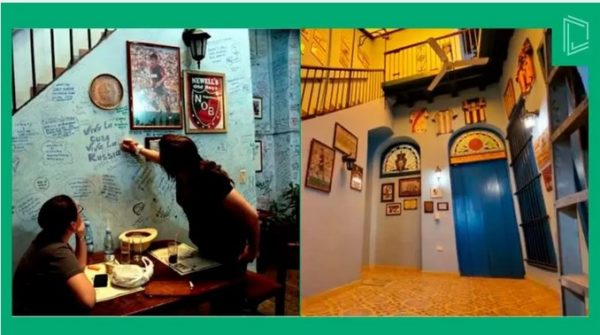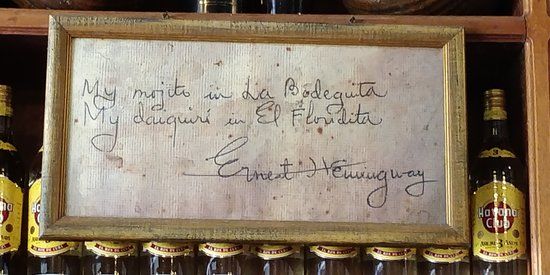Havana’s “La Bodeguita del Medio” Deletes its Signatures

By Meilin Puertas Borrero (El Toque)
HAVANA TIMES – Photos of the famous “La Bodeguita del Medio” bar in Havana with a fresh lick of paint, both inside and out, went viral on social media. The signatures on its walls that made the bar stand out from other tourist spots in Cuba have been deleted.
The creative director of the Cuban magazine Vistar, Robin Pedraja, published recent photos of this bar/restaurant on his Facebook page, where you can see flawless walls, painted in blue. “Whose idea was it to delete all of this heritage?” he posted. Others have also voiced their outrage.
While official media and institutions have remained quiet about the issue, according to 14ymedio newspaper, Jose Miguel Pumarada (the bar/restaurant’s manager), told them that recent renovations were necessary due to the poor state of the facilities.
“There were leaks everywhere, customers were eating, and water was falling down onto the table, there was a lot of damp. Paintings were falling off the walls because the plaster had rotted, there was so much damp and customers would complain,” he said.
Pumarada also said that the maintenance work carried out respected everything that was considered an asset, such as the book of signatures, photos and their frames, wood, the place’s structure and architecture. He also said that “signatures weren’t heritage”, in order to dodge the controversy.
Alleged statements from Pumarada to Radio Taino have gone viral on social media, in which he says that the signatures were wiped away for political reasons, among other reasons. These revelations are false and were denied by this state-controlled media outlet on its official Twitter account.
Visual artist and restorer Salome Garcia Bacallao responded on Facebook saying that “the outrage that this intervention has stirred just goes to prove that the local community and society consider signatures to be heritage, and they have historic, social, cultural and also emotional value.
“I hope the day comes soon when we can have open conversations in Cuba about the community’s participation in conservation and heritage status, where the community can audit how public budgets are being spent,” she added.
La Bodeguita del Medio isn’t on the list of Cuba’s national or local monuments; however, its symbolic value and especially its status as a cultural icon in Havana is undeniable.
Cultural heritage can be any object, resource, etc., that has a cultural, educational, representative or identity value for a region or community. Bearing this definition in mind, institutions normally propose files to recognize the heritage value of these places, objects, etc. However, just because institutions don’t recognize it as heritage, does not mean that these can’t be considered heritage by other communities.
The National Council of Cultural Heritage, belonging to the Ministry of Culture, is the authority responsible for specifying and declaring assets that form part of the country’s cultural heritage and this is regulated by the National and Local Monuments Act, which was passed in 1977. There are also Provincial Monument Committees.
According to responses from Pumarada to 14ymedio, renovations carried out recently were “approved at every level”.
Famous signatures
This bar/restaurant found on Empedrado street, around the corner from Plaza de la Catedral, in Old Havana, has welcomed many Cuban and foreign celebrities, such as Nicolás Guillén, Ernest Hemingway, Mario Benedetti, Pablo Neruda, Gabriel García Márquez, Alejo Carpentier, Gabriela Mistral, Mario Moreno “Cantinflas”, to name a few.
There are famous signatures that need to remain intact, such as Hemingway’s, as it wasn’t written on the wall, but on a napkin, which was then later framed: “My mojito in La Bodeguita, my daiquiri in El Floridita,” the dedicatory reads.

On the other hand, the signatures deleted from the walls will be impossible to recover, for according to a post by Lenore Herrera on Facebook (who called La Bodeguita) the walls were stripped as part of the renovations. Furthermore, it is still unknown whether visitors will be able to leave their mark, like they did before.
El Toque’s DeFacto went to La Bodeguita del Medio to get answers to these and other questions; but even though the manager and other employees were present, no explanations were given on the matter.
La Bodeguita del Medio, which belongs to the Palmares Extra-Hotel Company Ltd., is currently closed to the public due to restrictions that are meant to keep COVID-19 in check.
It will celebrate 80 years in 2022, and while it was a simple neighborhood bodega shop with the special feature of being half-way down the block, it managed to survive time and politics to become an emblematic place, the birthplace of the Cuban mojito.






Regular, average people’s signatures and phrases, along for what some might consider “Bulk graffiti” and mundane, is as much a part of the history and valued heritage of what made that place a historic location worth of preservation as the “few” notable signatures of famous people that visited. Is a shame that the Cuban government and the people responsible for the restoration couldn’t see it’s value. Is also ignorance to assume that a building could not be repaired and would have needed to crumble down in order for it’s history to be maintained. Restorations of buildings in higher state of damaged have been made times over without the need to abolish it’s history and heritage. It was the fact that an average person could walk in one day looking to find their grandparent’s signature, or to discover that that mundane graffiti was maybe done by an artist that is years in the future recognized as one of the greatest. I feel sorry for the lost of all of that, and a small thanks that Eusebio Leal was dead when that atrocity was made, as it would have surely killed him. He would have never allowed such an atrocity of history.
All that was preserved was the building, because “La Bodeguita del Medio” was most definitely NOT!
To be fair, while there were a few notable signatures such as Neruda’s and Grabriel Garcia Marquez’ , the bulk of the graffiti was mainly “Joe Schmo from Toronto was here.” Faced with the choice of keeping these exuberant but mundane graffitis or stabilizing and repairing the building itself is self evident. Cubans and tourists lament the crumbling state of their buildings and thus should be glad an historic location was preserved. The important pictures were maintained so I think the essence of the place is still there.
Someone just does not see the value to the Cuban economy, restoration was needed to preserve this history. To just stand in front of those that signed their names in the creation of Cuban history, the loss cannot be measured from a Cuban stand point & as the tourist world was concerned we were not of importance. Dam shame it was not sold off at auction to the world’s historians, I guess Cuba never needed the cash anyway.